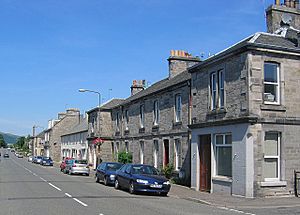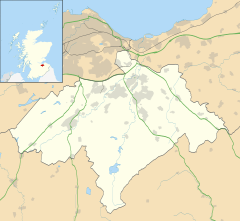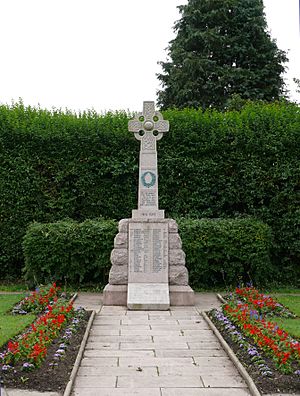Roslin, Midlothian facts for kids
Quick facts for kids Roslin |
|
|---|---|
 The centre of the village |
|
| Population | 1,770 (2020) |
| OS grid reference | NT268634 |
| Council area | |
| Lieutenancy area | |
| Country | Scotland |
| Sovereign state | United Kingdom |
| Post town | ROSLIN |
| Postcode district | EH25 |
| Dialling code | 0131 |
| Police | Lothian and Borders |
| Fire | Lothian and Borders |
| Ambulance | Scottish |
| EU Parliament | Scotland |
| UK Parliament |
|
| Scottish Parliament |
|
Roslin (also spelled Rosslyn or Roslyn) is a village in Midlothian, Scotland. It's about 11 kilometers (7 miles) south of Edinburgh, the capital city. The village sits on high ground, near the northwest bank of the North Esk river.
Contents
What Does the Name Roslin Mean?
The name Roslin was first recorded in 1138 as Roskelyn. It seems to come from Scottish Gaelic, an old language spoken in Scotland. The second part of the name, linne, usually means a pond or lake. But here, it probably means a waterfall, referring to the nearby Linn of Roslin. The first part of the name is less clear, but it might come from riasg, which means a peat moor (a type of wet, boggy land).
Some people have a fun theory that the name comes from "Rose line," a special line they think went through Paris and Rosslyn Chapel. However, this idea is not based on facts.
Roslin is thought to be the reason for the name of the Village of Roslyn in New York, United States. Its location reminded people there of the hills in Roslin. Another place, Roslindale, in Massachusetts, is also named after Roslin.
A Look at Roslin's History
Early Times and Important Battles
An old story says that the village of Roslin was started in 203 A.D. by a Pict named Asterius. The Picts were ancient people who lived in what is now Scotland.
In 1303, Roslin was the location of a big battle during the First War of Scottish Independence. This war was fought between Scotland and England.
The Famous Rosslyn Chapel
In 1446, the famous Rosslyn Chapel was built. It was constructed under the guidance of William Sinclair, 1st Earl of Caithness.
Roslin became very important because it was the home of the St Clair (or Sinclair) family. In 1456, King James II of Scotland gave Roslin the special status of a burgh. This meant it was an important town with its own rights.
Life and Visitors in Roslin
For many centuries, from the 1100s to the late 1900s, coal mining was a major job for people in Roslin.
The Roslin Inn, a local hotel, has been around since 1660. Famous visitors like Dr. Johnson and James Boswell stayed there in 1773 during their trip around Scotland. Later, in the 18th century, the famous poet Robert Burns had breakfast at the inn with Alexander Nasmyth.
From the 1800s onwards, Roslin became a popular place for tourists. People loved to visit the beautiful Glen, the Castle, and the Chapel. Many well-known artists and writers came to see Roslin. These included J. M. W. Turner, a famous painter, and William Wordsworth, a poet who wrote a poem in the chapel. His sister, Dorothy, also visited and wrote about how lovely the area was.
Dolly the Sheep and Science
On the northwest side of the village, there used to be the Roslin Institute. This was a special place for biological research. In 1996, something amazing happened there: Dolly the sheep became the first animal to be cloned from an adult cell. This was a huge scientific breakthrough! Dolly later moved to Easter Bush in 2011.
Interesting Places to Visit in Roslin
The village of Roslin is located on the west side of Roslin Glen, which is now a country park. Looking over the Glen, you can see two very famous places: Rosslyn Chapel and Roslin Castle.
Rosslyn Chapel: A Place of Mystery
The Rosslyn Chapel is known for its amazing and detailed carvings. It has long been connected to the Knights Templar, a medieval group, and the Grail legend. The chapel became even more famous when it was featured in the best-selling book The Da Vinci Code. Later, it was used as a filming location for the movie based on the book. All this attention greatly increased the number of visitors to Roslin.
Roslin Castle: An Old Stronghold
Rosslyn Castle has belonged to the family of the Earl of Rosslyn since the 1300s. Parts of the castle are now in ruins, but some parts are still in good condition. These parts are rented out as holiday homes.
Battle of Roslin Monument
There is a monument called a cairn in Roslin. It was built by the Roslin Heritage Society to mark the spot where the Battle of Roslin took place.
Famous People from Roslin
- James Gillespie (1726–1797) was a snuff-maker and a kind person who gave money to good causes.
- David Gray is a footballer who scored the winning goal for Hibernian in the 2016 Scottish Cup Final. This was their first win since 1902!
- John Lawson Johnston, who invented the popular food spread Bovril, was born in Roslin in 1839.
See also
 In Spanish: Roslin para niños
In Spanish: Roslin para niños



